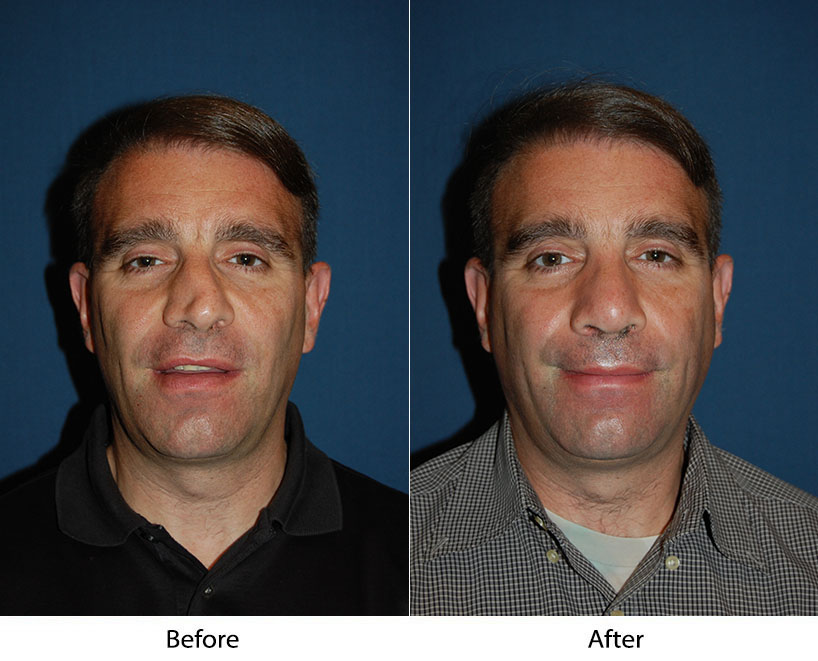Rhinoplasty specialist can help you avoid nasal collapse
Charlotte’s top rhinoplasty specialist can help you enjoy natural-looking results. Rhinoplasty, commonly known as a “nose job,” is a surgical procedure performed to reshape or reconstruct the nose. It is one of the most popular cosmetic surgeries worldwide, sought after for both aesthetic and functional reasons. Whether to correct a congenital defect, improve breathing, or enhance facial harmony, rhinoplasty can yield significant and transformative results.
During rhinoplasty, a surgeon may modify the nasal bones, cartilage, and tissues to achieve the desired outcome. Techniques can vary depending on the individual’s needs but commonly involve making small incisions either inside the nostrils (closed rhinoplasty) or across the columella (open rhinoplasty). Through these incisions, the surgeon can access and sculpt the nasal structures, reshaping the nose to achieve the desired aesthetic or functional improvement.
Despite the skill and precision involved in rhinoplasty procedures, there are potential risks and complications associated with any surgical intervention. One concern that patients often inquire about is the possibility of nose collapse after rhinoplasty. In this article, we will delve into this topic to provide a comprehensive understanding of the factors contributing to nasal collapse post-rhinoplasty.
Risks of Nose Collapse After Rhinoplasty
Nasal collapse, also known as nasal valve collapse or nasal tip collapse, refers to the weakening or collapse of the nasal structures following rhinoplasty. While the risk of nose collapse is relatively low, patients need to be aware of the factors that may increase the likelihood of this complication.
- Over-Resection of Nasal Structures: One of the primary reasons for nose collapse after rhinoplasty is the excessive removal of nasal cartilage or bone. When the surgeon removes too much tissue during the procedure, it can compromise the structural integrity of the nose, leading to instability and eventual collapse. Over-resection is more common in inexperienced surgeons or in cases where patients request aggressive reshaping beyond what is anatomically feasible.
- Weak Nasal Support: Some individuals naturally have weaker nasal support due to thin skin, inadequate cartilage, or previous trauma. In such cases, the nasal structures may be less resilient to surgical manipulation, increasing the risk of collapse post-rhinoplasty. Surgeons must assess the patient’s nasal anatomy thoroughly and tailor the surgical approach to provide adequate support and stability.
- Inadequate Healing: Proper healing is crucial for the long-term success of rhinoplasty. If the nasal tissues do not heal properly following surgery, it can compromise the structural integrity of the nose and predispose it to collapse. Factors such as smoking, poor wound care, or underlying medical conditions can impede the healing process and increase the risk of complications.
- Trauma or Injury: In some cases, nasal collapse may occur due to trauma or injury sustained after rhinoplasty. Accidental bumps or blows to the nose during the initial stages of healing can disrupt the surgical outcomes and lead to deformities or collapse. Patients must follow post-operative instructions provided by their surgeon to minimize the risk of trauma during the recovery period.
Preventive Measures and Treatment Options
While the risk of nose collapse after rhinoplasty exists, there are preventive measures and treatment options available to address this complication effectively.
- Preoperative Assessment: A thorough preoperative assessment is crucial to identify patients at risk of nasal collapse. Surgeons must evaluate the patient’s nasal anatomy, skin thickness, and structural integrity to determine the most suitable surgical approach. Imaging techniques such as CT scans or 3D simulations can aid in surgical planning and minimize the risk of over-resection.
- Conservative Surgical Techniques: Employing conservative surgical techniques is paramount in reducing the risk of nasal collapse. Surgeons should prioritize preserving nasal support structures and avoiding excessive tissue removal. By maintaining adequate support and stability, surgeons can enhance the long-term integrity of the nose and minimize the risk of collapse.
- Use of Structural Grafts: In cases where patients have weak nasal support or thin skin, surgeons may utilize structural grafts to reinforce the nasal framework. Cartilage grafts harvested from the septum, ear, or rib can provide additional support and stability, reducing the likelihood of collapse. Strategic placement of grafts can help strengthen weak areas and enhance overall nasal structure.
- Optimizing Healing: Ensuring optimal healing is essential for preventing nasal collapse post-rhinoplasty. Patients should follow their surgeon’s post-operative instructions diligently, including avoiding strenuous activities, refraining from smoking, and attending follow-up appointments. By promoting proper wound healing and tissue regeneration, patients can minimize the risk of complications and achieve satisfactory outcomes.
- Revision Rhinoplasty: In cases where nasal collapse occurs despite preventive measures, revision rhinoplasty may be necessary to address the issue. Revision surgery allows the surgeon to correct deformities, reinforce nasal support, and restore aesthetic balance. Patients need to communicate openly with their surgeon regarding concerns or dissatisfaction with the surgical outcomes to explore appropriate treatment options.
Nasal collapse after rhinoplasty is a potential complication that requires careful consideration and proactive management. By understanding the risk factors, preventive measures, and treatment options associated with nasal collapse, patients can make informed decisions and collaborate effectively with their surgeons to achieve desirable outcomes.
Choosing a qualified and experienced rhinoplasty specialist is paramount in minimizing the risk of complications and ensuring a safe and successful surgical experience. Patients in Charlotte and beyond can benefit from consulting with top rhinoplasty specialists who prioritize patient safety, surgical precision, and aesthetic excellence.
Through comprehensive preoperative assessments, conservative surgical techniques, and meticulous post-operative care, patients can minimize the risk of nasal collapse and enjoy the transformative benefits of rhinoplasty with confidence and peace of mind.
Visit Charlotte’s top rhinoplasty specialist
Contact Dr. Sean Freeman at Only Faces, Charlotte’s most experienced rhinoplasty surgeon and top facial plastic surgeon, to schedule a consultation to find out what procedure is right for you. Call today.

